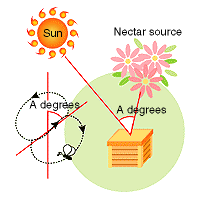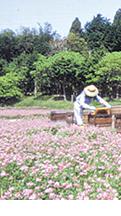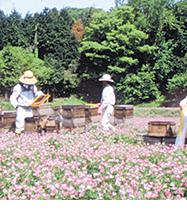 |
| Bee Square HOME | The Miraculous Life of Bees | A Surprising Story about Bees | Look into a honeycomb! | An Introduction to Beekeeping |
| Honeybee Restaurant | Beekeeping Reports from Around the World | Fairy Tales and Picture Books about Bees Story Collection | News From the Bee Farm | Links |
|
|

 |
Hiroto Fujiyoshi |
|
We have been trying our best to increase the number of milk vetch fields by asking the farmers around the bee farm to sow more milk vetch seeds. However, we will probably never return to those days when we could see a landscape filled with "milk vetch fields stretching in all directions," a phenomenon which once brought us the real feeling of spring, for the following reasons:
By the way, I sometimes get asked "Can't bees fly over to other flowers that are blooming during the same period?" Surely, when milk vetch flowers bloom, dandelion and wild cherry blossoms bloom and even onion heads may bloom. However, here bees apply the principle of efficiency. It starts with the selection of flowers that bloom closest to the beehive. This is quite natural. Then, they give greater priority to flowers that bloom all around the hive like milk vetch flowers, than they do to flowers that are fewer in number. In addition, they select flowers with a higher sugar content, from among the different varieties of flower in the field. (The sugar content in the nectar differs with the flower type.) When making honey, honeybees have to boost the concentration of nectar with a low sugar content to about 80% by fluttering their wings to evaporate the water. Thus, they naturally select nectar with a higher sugar content to reduce the required work. When honeybees return to their beehive, they perform the 8-form dance to show other bees the location of the flowers. In this manner, they store honey made using the same type of flower. Therefore, beekeepers place the beehives as close as possible to the flowers from which nectar should be collected. Still, it is not possible to completely prevent other types of nectar from being mixed in because it is a natural product, in contrast to industrial products. After all, the quality of the products is guaranteed based the judgment of the experienced beekeeper, who makes his or her evaluation by taste testing the honey from each of the collected cans.
|
|||||||||||||||
Yamada Bee Farm (Kagaminocho Pref. Okayama)
Copyright(C)2005 Yamada Bee Farm All Rights Reserved.
|





